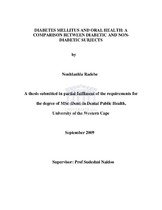| dc.description.abstract | Diabetes is often associated with a number of medical complications as a result of the metabolic changes taking place systemically. There is considerable evidence it is associated with oral complications including among others, gingivitis, periodontal
disease, xerostomia, oral candidiasis, dental caries, periapical abscesses, lichen planus,burning mouth syndrome and an altered taste sensation (Lamster et al. 2008; Skamagas et al. 2008; Vernillo, 2003). The aim of the present study was to compare the oral health status in diabetic and non-diabetic patients with regards to their oral health problems, oral pathology and self perceived quality of life.A comparative cross-sectional study to determine the common oral complications
prevalent in diabetics and non-diabetics was carried out in KwaZulu-Natal, at Prince
Mshiyeni Memorial, EThekwini District, Umlazi. The study sample consisted of 150
diabetic patients and 150 non-diabetic patients attending the hospital. The oral health status was assessed clinically for each patient and recorded prior to the interview. The DMFT, plaque index and appearance of marginal gingiva were used to assess oral health status. An intra-oral examination was carried out to identify oral pathology lesions and other oral problems. Patients were then interviewed on the self perceived quality of life and the impact that diabetes has had on their lives.
Plaque Index and DMFT were significantly higher among the diabetic group as opposed to the non-diabetic group. Periodontal disease was observed in more than half of the diabetic group as opposed to only 14.7% of the non-diabetic group.
Except for tooth decay, the diabetic patients had more oral health problems compared to the non-diabetic group. More than half of the diabetic group reported having xerostomia compared to only 7.3% of the non-diabetic group. Altered taste sensation was also more prevalent in the diabetic group. In general, the diabetic group demonstrated a higher prevalence of oral pathology lesions and medical diabetes complications compared to the non-diabetic group.The self perceived quality of life was said to have deteriorated in 92% of diabetic subjects due to concomitant diabetic complications and 75% of this group indicated that they were not satisfied with their current quality of life.Diabetic patients were significantly less likely to perceive their quality of life as very satisfied after having adjusted for age and gender variables (OR=0.0188; CI: 0.0059-0.0594). Furthermore, diabetic patients were almost 6 times more likely to perceive themselves as “not satisfied” with their quality of life (QOL) as compared to non-diabetic patients.Individuals with diabetes exhibited poorer oral health when compared to non-diabetics.They exhibited a higher DMFT and had a significantly higher average number of missing
teeth compared to the non-diabetic group. Special care needs to be given to diabetic patients because of the associated complications to improve their quality of life. A more detailed and in-depth study that utilises a diabetes-specific quality of life instrument may provide a more accurate way of determining the quality of life as well as periodontal disease in patients. | en_US |

